The Giza Power Plant (28 page)
FIGURE 54.
Hydrogen
With the granite beams vibrating at their resonant frequency, the sound energy would be converted through the piezoelectric effect of the silicon-quartz crystals embedded in the granite, creating high-frequency radio waves. Ultrasonic radiation would also be generated by this assembly. The hydrogen
generated in the Queen's Chamber, directly below the King's Chamber, would fill the upper chambers and then efficiently absorb this energy as each atom responded in resonance to its input.
Hydrogen, as I explained, is the simplest atom, having only one electron and one proton. The electron is "pumped" with energy to a higher energy level. In other words, the electron is induced to increase its distance from the proton. This is an unnatural state for the electron to be in, and in time it will fall back to its "ground state;' releasing a packet of energy as it falls (see Figure 54). The electron can be stimulated to fall back to ground state through the action of an input signalâanother packet of energyâthat is of the same frequency. The result is that the input signal continues its path after stimulating emission from the hydrogen atom and carries the energy released by the electron with it.
In the Giza power plant, the Northern Shaft served as a waveguide through which the input microwave signal traveled. A typical waveguide is rectangular in shape, with its width being the wavelength of microwave energy and its height measuring approximately one-half its width. The Northern Shaft waveguide was constructed precisely to pass through the masonry from the north face of the pyramid and into the King's Chamber. That microwave
signal could have been collected off the outer surface of the Great Pyramid and directed into the waveguide (see Figure 55).
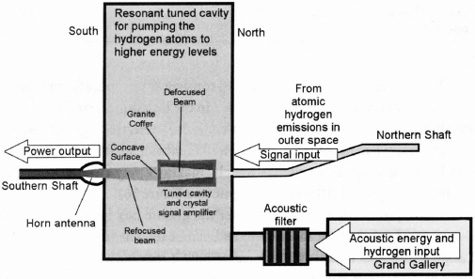
F
IGURE
55.
The Pyramid MASER
The (originally smooth) surfaces on the outside of the Great Pyramid are "dish-shaped" and may have been treated to serve as a collector of radio waves in the microwave region that are constantly bombarding the Earth from the universe. Amazingly, this waveguide leading to the chamber has dimensions that closely approximate the wavelength ofmicrowaveenergyâ1,420,405,751.786 hertz (cycles per second). This is the frequency of energy emitted by atomic hydrogen in the universe. These features and facts are gathered in Table 3.
| T ABLE 3 | Â | Â |
| D ESCRIPTION | M EASURE | U NIT |
| Frequency of atomic hydrogen (hf) 3 | 1,420,405,751.786 | hertz |
| Speed of electromagnetic radiation (light) per second (c) | 186,282 | miles |
| 11,802,827,520 | inches | |
| Wavelength of hydrogen microwave energy (c ÷ h) | 8.309 | inches |
| Width of Northern Shaft leading to King's Chamber 4 | 8.4 | inches |
| Height of Northern Shaft leading to King's Chamber 5 | 4.8 | inches |
These features inexorably move us to consider the purpose for the goldplated iron that was discovered embedded in the limestone near the Southern Shaft. In order to have an efficient conduit for electromagnetic radiation, the entire lengths of the Northern and Southern Shafts would have to have been lined with this material, thereby making a very efficient conduit for the input signal and the power output (see Figure 56).
I have puzzled for a long time over the granite box inside the King's Chamber. This box, now located at the back of the chamber, is a critical component in this maser, and to imagine how it may have been used I am compelled to move it from its current position and place it between the waveguides in the north and south walls. There is evidence that leads me to
suggest that it occupied this position and served to amplify the microwave signal that entered the resonant cavity. To understand how the granite box may have functioned, it would help to understand the basic principles of how optics function. Normally we associate optics with visible light. Most of us are familiar with telescopes, binoculars, and spectacles, andâwith the exception of mirrorsânaturally assume that we should be able to see through them. But that is not always the case. The material from which an optic is made depends on the wavelength of electromagnetic radiation that passes through it. As humans, we are equipped to see electromagnetic radiation (light) that lies in what we call the visible spectrum. There is light, however, below and above the visible spectrum that we are not physically equipped to see. If we were, we would be able to see through some of the opaque materials that allow these wavelengths to pass freely.
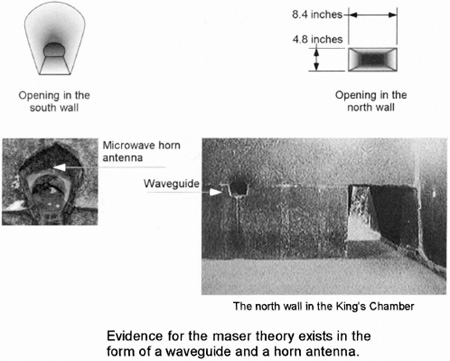
F
IGURE
56.
Microwave Horn Antenna and Waveguide
For example, the wavelength of a Nd.YAG (Neodymium.Yttrium-Arsenate-Garnet) laser is 1.06 microns. Optical components that pass light
of this frequency also pass visible light. A CO
2
laser, on the other hand, has a wavelength that is 10.6 micronsâten times greater than a Nd.YAGâand the most efficient and cheapest material for passing CO
2
laser light is gallium arsenide, which humans like you and I cannot see through. If we want an example of a material that is opaque and yet passes electromagnetic radiation, we have to look only as far as the kitchen cabinets for the containers that we place in the microwave oven. Microwaves pass through an opaque dish and heat the food it contains. The granite coffer, densely opaque to us, would allow electromagnetic radiation, invisible to us, to pass through.
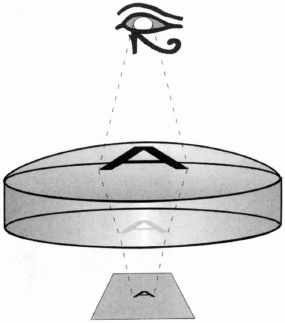
F
IGURE
57.
Refraction
Having a material present that allows microwave energy to pass through, we can apply the basic principles of optics that affect all wave phenomena, including electromagnetic radiation. These principles are reflection and refraction. Reflection, of course, is a look in the mirror. Refraction explains the focusing of a lens, such as a magnifying glass (see Figure 57). For instance, lenses are ground with a curvature that refracts light in such a way that it is either focused or diverged, depending on the application. Eyeglasses are ground so that they focus the light rays that pass through them, bringing objects into clearer view.
There is evidence to suggest that the granite box could refract electromagnetic radiation as it passed through the box's north and south walls. Though fully accurate measurements for optical characteristics have not been made on these surfaces, Smyth's measurements show that the grinding on these surfaces produced a concave
surface.
6
Manufactured in such a manner, the cofferâpositioned in the path of the incoming signal through the Northern Shaft and with oscillating crystals adding energy to the microwave beamâmay have served to spread or diverge the signal inside the box as it passed through the first wall. Within the confines of the granite box, the spreading beam would then interact and stimulate the emission of energy from the energized, or "pumped," hydrogen atoms (see Figure 58).
If we follow a straight line across the King's Chamber from where the Northern Shaft enters, we find a feature cut into the granite wall that closely resembles a horn antenna, much like a microwave receiver. Passing through the opposite wall of the coffer, then, the radiation picked up more energy, was once more refracted, and then focused into this horn antenna. The mouth of this opening shows signs of being severely damaged. Because of the curved geometry of this opening, somebody in the distant past probably found it necessary to hack away some of the granite in order to retrieve the gold or gold-plated metal lining. Nevertheless, what is left unmistakably identifies this feature as the receiver of microwave energy that entered the chamber from the waveguide in the north wall.
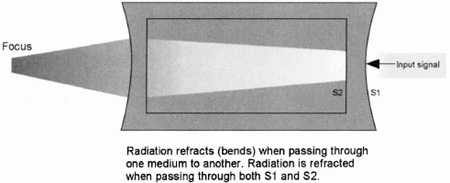
F
IGURE
58.
Lens Effect of the Granite Box
With the preceding data, we can explain many mysteries found in and around the King's Chamber. Compelling evidence clearly identifies the King's Chamber as the power center of the Giza power plant and strongly suggests that microwave energy was flowing through the southern "air shaft" and utilized on the outside. However, as I said earlier, any theory purporting to explain the purpose of the Great Pyramid should explain
all
noted phenomena. We still have not addressed the purpose for the Queen's Chamber, Horizontal Passage, Well Shaft, and Subterranean Pit. Neither have we studied how the hydrogen gas may have got inside the pyramid. As a matter of fact, we can answer all of these questions if
we look more closely at the Queen's Chamber, where we will find the evidence that proves it was used to generate hydrogen, the fuel that ran the Giza power plant.
Chapter Eleven
A HYDROGEN GENERATOR

I
am indebted to Rudolph Gantenbrink for his exploration of the
Southern Shaft in the Queen's Chamber. I can understand his frustration at not being allowed to explore further inside the Great Pyramid, but am delighted that his discovery at the end of the shaft provided conclusive evidence for what I am about to discuss in this chapter.
Without hydrogen this giant machine would not function. It was the medium by which the energy drawn through the Great Pyramid was converted and transmitted to the outside. The hydrogen for the operation of the maser was generated by a chemical reaction in the Queen's Chamber. The characteristics and discoveries in this chamber strongly suggest that two solutionsâsuch as hydrated zinc chloride and a dilute solution of hydrochloric acidâmay have been introduced to cause a chemical reaction that produced hydrogen. There are other ways to create hydrogen, such as electrolysis; however, I am going to discuss only one method and the evidence that exists to support it.
The Queen's Chamber is located in the center of the pyramid. There are two shafts leading to this chamber which were bored into the wall block and terminated five inches from the inside wall of the chamber, leaving what Smyth described as
a "left" (see Figure 59). The discovery of these enigmatic shafts came in 1872 when Waynman Dixon was able to thrust a rod through a small crack in an otherwise perfectly fitted wall and then chiseled through the limestone. Dixon noted that the limestone "left" was particularly soft in that area. Emboldened by this important discovery he measured off the same distance on the other wall and discovered another shaft. The channels were quickly theorized to be air channels; and it was surmised that the builders were not required to ventilate this chamber at
the time of building, but were making preparations in case they might change their minds at a later date.
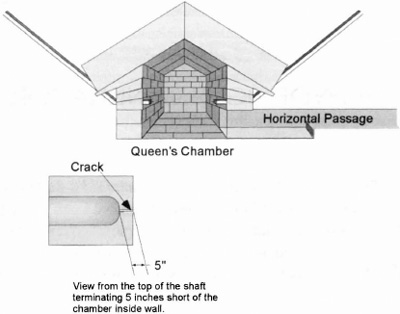
F
IGURE
59.
Queen's Chamber Shafts
While some Egyptologists have proposed that the shafts leading to the Queen's Chamber were included in the design to provide air to that chamber, there is a simple and obvious fact that proves the theory to be wrong. A shaft cannot pass air from the outside to a chamber if the shaft is blocked at both endsâas the Queen's Chamber shafts are. Therefore it is amazing that such a speculation would be made. Even if these shafts were open at both ends, they do not have the most efficient design to be air shafts. Although it could be argued that the shafts were built on an incline to make the shortest route to the outside, a horizontalâalbeit longerâshaft would be quicker and easier to build. For a horizontal shaft, the faces of the blocks and the channel that runs through each block, comprising the walls and ceiling of the shaft, would not have to be cut on an angle (see Figure 60). Neither would the surface that provided the floor for the shaft. The blocks could sit on a single course of masonry.
Smyth is credited for noting another anomaly in the Queen's Chamberâthere were flakes of white mortar exuding from stone joints inside
the shaft. Analysis of the mortar found it to be plaster of parisâgypsum (calcium sulfate). Smyth also described this chamber as having a foul odor, which caused early visitors to the chamber to beat a hasty retreat, and it was assumed that tourists were relieving themselves, though the way Smyth described this chamber, few people stayed long enough to do so. However, as I will make clear, this odor may not have been the result of unhygienic conditions but of the chemical process that once occurred in the Queen's Chamber.
One of the greatest mysteries of this chamber has been the salt encrustation on the walls. It was up to one-half-inch thick in places, and Petrie took it into account when he made measurements of the chamber. The salt also was found along the Horizontal Passage and in the lower portion of the Grand Gallery. How did salt come to build up on the walls?
Those who have seen some significance in the presence of the salt have speculated that it could have been deposited on the walls as the water of the biblical Great Flood receded. Others have speculated that the Great Pyramid and its neighbors were surrounded by water at one time. There has been no
evidence, however, to support such speculations; in fact, one researcher, after clambering over the sides of the Great Pyramid looking for water marks, concluded that such speculations were groundless.
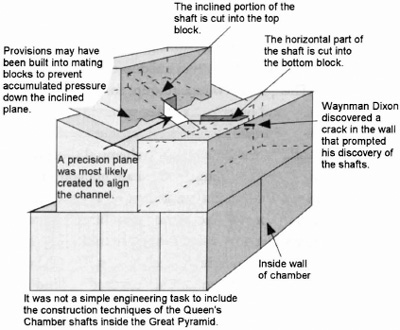
F
IGURE
60.
Southern Shaft in the Queen's Chamber
The flood and groundwater theories do not account for the salt found in the Great Pyramid, but proponents of these theories might be right about one thingâthe existence of the salt itself suggests that the Queen's Chamber was designed to take in fluid rather than air. The power plant theory explains why fluid may have been introduced into the pyramid and how it produced the salt encrustations on the walls. Nearly all of the facts that have so mystified Egyptologists fit logically together if the Queen's Chamber was once used to create hydrogen to fuel this power plant.
Salt is a natural by-product of the reaction designed to produce hydrogen. It would form when the hot, hydrogen-bearing gas reacted with the calcium in the pyramid's limestone walls. If the half-inch of salt on the Queen's Chamber walls were the result of repeated inundationsânot of waterâof chemicals, those used to create the fuel that powered the plant, it is unlikely that any of this chemical fluid would find its way into the bottom part of the Grand Gallery. The orientation of the passage leading from the Queen's Chamber would take the chemicals down into the Well Shaft and into the Subterranean Pit. Because the greatest concentration of heat would be inside the Queen's Chamber, with a gradual cooling off as the gas made its way into the Grand Gallery, the buildup of salt would diminish along with the heat. This process would account for the presence of salt in the Queen's Chamber and other parts of the pyramid and also for its uneven distribution in these areas.
The kind of salt that is created in a chemical process depends on the chemicals involved in generating the gas. I am not going to argue for a particular combination of chemicals, and say that is the combination the ancient Egyptians used. But I will present one feasible combinationâsuggested to me by a chemical engineerâwith the understanding that the pyramid builders may have used a different one. Before I proceed, however, we must consider the material the pyramid builders used to bind those limestone blocks adjacent to the shafts in the Queen's Chamber. We remember that Smyth noted a white, flaky material exuding from the joints of these blocks. He was sufficiently interested in this material to have it chemically analyzed,
and it was found to be gypsum, or plaster of paris. However, it is possible that this material was not used by the builders in this area at all, and if not, then we are provided with another clue to the real purpose of the Queen's Chamber. Let us briefly detour in order to find out a little more about exactly what plaster of paris is and how it could have come to be in the shafts of the Queen's Chamber.
Plaster of paris is dehydrated gypsum, which, when moistened with water, sets in a relatively short time. It got its name because gypsum was widely used near Paris to make plaster and cement. In nature, gypsum is a form of sedimentary rock, formed by the precipitation of calcium sulfate from seawater. It also is found in various other saline deposits.
It is possible that the ancient Egyptian builders used plaster of paris in the joints in the shafts to retard the absorption of fluid into the surrounding masonry. However we should not exclude other possibilitiesâone of which is another method of creating gypsum that could lead to some extremely interesting conclusions. Gypsum also is produced through the action of sulfuric acid on limestone, and, although this in itself does not prove that sulfur and/or its by-products were used in the chemical process in this chamber, it does promote the consideration of other data in a new light. Because the pyramid's building materials contain one of the elements needed to produce gypsum (the limestone masonry), it follows that the introduction either accidental or purposefulâof another necessary element (sulfuric acid, for instance) would produce gypsum.
Several questions come to mind in light of the preceding speculations. They may be totally unrelated, but it would be interesting to know the answers to the following:
- Was the disgusting smell that caused early explorers to beat a hasty retreat from the chamber connected to a chemical process that used sulfur? Hydrogen sulfide is particularly odorous, exuding a smell similar to rotten eggs. This gas is formed by the combination of sulfur with hydrogen. While early explorers expected to be confronted with a certain amount of bat dung inside the pyramid, it seemed as though the smell in this particular chamber was more pronounced than in the rest of the pyramid. Again, the composition of the salts on the
chamber's walls may help clarify this investigation, as sulfur-bearing compounds may have formed these salts. - Where did Caviglia get the chunks of sulfur that he burned in the Well Shaft? While it was a practice of early explorers to burn sulfur to purify unhealthy air, it would be most helpful to know whether or not he had the sulfur with him or if it was already there.
- If a chemical exchange process was separating hydrogen and if a catalyst was being used in the Queen's Chamber, would sulfur playa part in the operation or perhaps regeneration of the
catalyst?
1
The shafts leading to the Queen's Chamber revealed other oddities that may help our investigation into its true function. In these channels, explorers found a small bronze grapnel hook, a piece of wood, and a stone ball. Though their discovery was much publicized at the time, Egyptologists say little about these artifacts today; and if Graham Hancock and Robert Bauval had not showed an interest, the experts would probably have preferred to leave it at that. Hancock and Bauval took it upon themselves to search for these relics. They contacted Egyptologist I.E.S. Edwards and the British Museum in 1993, but were told that they had no knowledge of them. The
Independent,
a British national newspaper, published an interview with Edwards in which he categorically denied any knowledge of these artifacts. Surprisingly, the following week, Dr. Vivian Davies, the Keeper of Egyptian Antiquities at the British Museum, stated in a letter to the
Independent
that the relics were in a cigar box in his department's keep. Subsequent investigation by Hancock and Bauval revealed that in 1972, Edwards had received the relics and recorded them in the museum's
log.
2
Was the fiasco surrounding the search for these relics a deliberate deception by Egyptologists? I seriously doubt it. These relics are pieces of evidence that do not fit into the orthodox tomb theory, so they probably had not been given any thought since the day they were delivered to the museum. Even if it was deceitâand the museum had intentionally kept them hiddenâhaving the relics now on display does not answer the question of why they were in the pyramid in the first place. Several questions remain unanswered regarding the discovery of these items, and the items themselves, that prevent any assertion as to their intended purpose:

